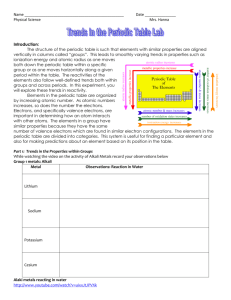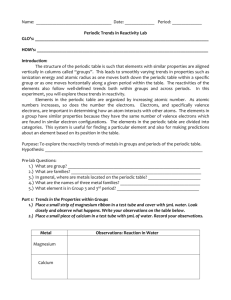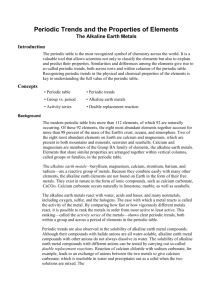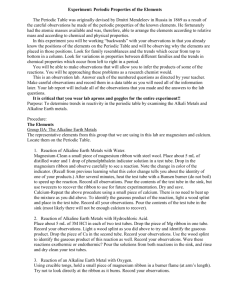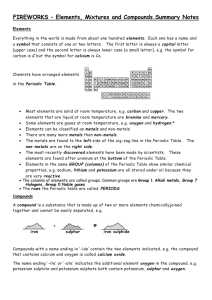Chemistry Lab - Single Replacement Reactions
advertisement
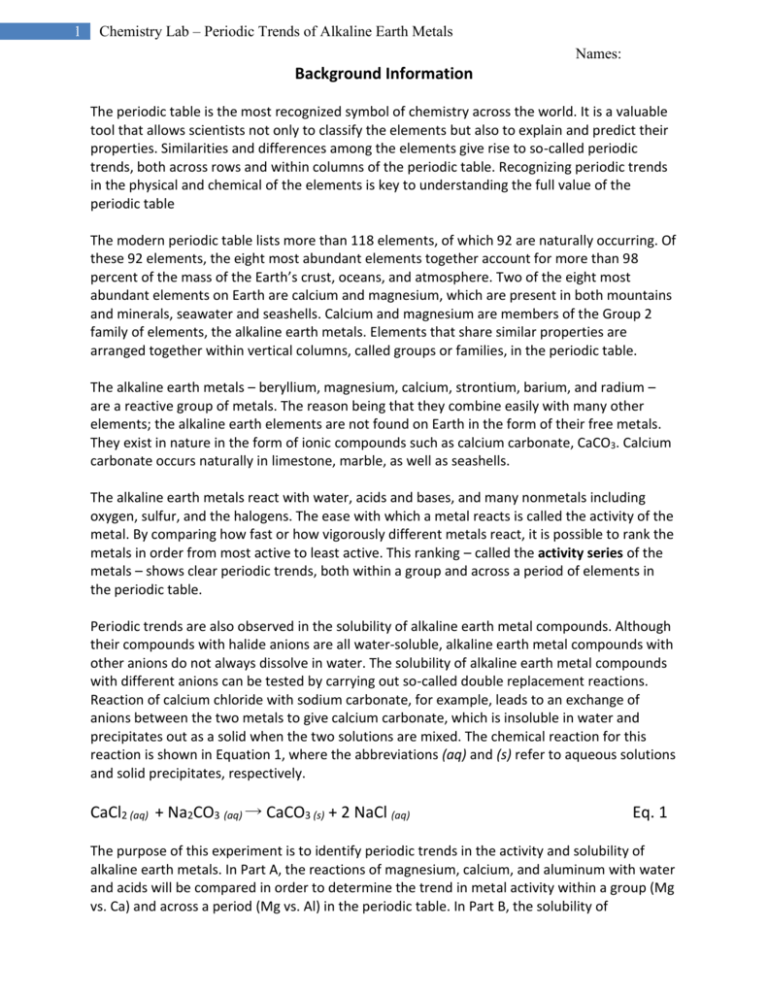
1 Chemistry Lab – Periodic Trends of Alkaline Earth Metals Names: Background Information The periodic table is the most recognized symbol of chemistry across the world. It is a valuable tool that allows scientists not only to classify the elements but also to explain and predict their properties. Similarities and differences among the elements give rise to so-called periodic trends, both across rows and within columns of the periodic table. Recognizing periodic trends in the physical and chemical of the elements is key to understanding the full value of the periodic table The modern periodic table lists more than 118 elements, of which 92 are naturally occurring. Of these 92 elements, the eight most abundant elements together account for more than 98 percent of the mass of the Earth’s crust, oceans, and atmosphere. Two of the eight most abundant elements on Earth are calcium and magnesium, which are present in both mountains and minerals, seawater and seashells. Calcium and magnesium are members of the Group 2 family of elements, the alkaline earth metals. Elements that share similar properties are arranged together within vertical columns, called groups or families, in the periodic table. The alkaline earth metals – beryllium, magnesium, calcium, strontium, barium, and radium – are a reactive group of metals. The reason being that they combine easily with many other elements; the alkaline earth elements are not found on Earth in the form of their free metals. They exist in nature in the form of ionic compounds such as calcium carbonate, CaCO3. Calcium carbonate occurs naturally in limestone, marble, as well as seashells. The alkaline earth metals react with water, acids and bases, and many nonmetals including oxygen, sulfur, and the halogens. The ease with which a metal reacts is called the activity of the metal. By comparing how fast or how vigorously different metals react, it is possible to rank the metals in order from most active to least active. This ranking – called the activity series of the metals – shows clear periodic trends, both within a group and across a period of elements in the periodic table. Periodic trends are also observed in the solubility of alkaline earth metal compounds. Although their compounds with halide anions are all water-soluble, alkaline earth metal compounds with other anions do not always dissolve in water. The solubility of alkaline earth metal compounds with different anions can be tested by carrying out so-called double replacement reactions. Reaction of calcium chloride with sodium carbonate, for example, leads to an exchange of anions between the two metals to give calcium carbonate, which is insoluble in water and precipitates out as a solid when the two solutions are mixed. The chemical reaction for this reaction is shown in Equation 1, where the abbreviations (aq) and (s) refer to aqueous solutions and solid precipitates, respectively. CaCl2 (aq) + Na2CO3 (aq) → CaCO3 (s) + 2 NaCl (aq) Eq. 1 The purpose of this experiment is to identify periodic trends in the activity and solubility of alkaline earth metals. In Part A, the reactions of magnesium, calcium, and aluminum with water and acids will be compared in order to determine the trend in metal activity within a group (Mg vs. Ca) and across a period (Mg vs. Al) in the periodic table. In Part B, the solubility of 2 Chemistry Lab – Periodic Trends of Alkaline Earth Metals Names: magnesium, calcium, strontium, and barium compounds will be studied and used to identify an unknown alkaline earth metal. Procedure Note: The numbers appearing in parentheses indicate the specific lines on your Data Sheet on which the indicated data should be entered. Chemical Alert: Calcium and magnesium are reactive, flammable solids and possible skin irritants. Use forceps or a spatula to handle these metals. Hydrochloric acid is toxic by ingestion and inhalation and is corrosive to skin and eyes; avoid contact with body tissues. Strontium and barium compounds are toxic by ingestion. Potassium iodate solution is moderately toxic and a strong irritant. Avoid contact of all chemicals with eyes and skin. Wear chemical splash goggles and chemical-resistant gloves and apron. Always wash hands thoroughly before leaving the laboratory. I. Part A: Activity of Metals 1. Place a spot plate on a white sheet of paper. Note that each well is identified by a unique combination of a letter and a number, where the letter refers to a horizontal row and the number to a vertical column 1 2 3 4 5 6 A B C D 4. Use a pipet or eyedropper to add 10 drops of distilled water into wells A1-A3 5. Test the water in one of the wells with a piece of red litmus paper and record this initial color for this litmus test on the Data Sheet. 6. In a weighing dish, small beaker, or on a piece of weighing paper obtain 2 small pieces of calcium turnings. 7. Obtain 2 small pieces of magnesium ribbon, approximately 1-cm each, and a short piece of aluminum foil. 8. Use forceps or tweezers, to add one piece of calcium to well A1. Record observations on the Data Sheet. 9. Use forceps to add one piece of magnesium ribbon to well A2. Record observations on the Data Sheet. 10. Tear off a 2-cm piece of aluminum foil and roll it into a loose ball. Add the aluminum metal to well A3. Record observations on the Data Sheet. If no changes are observed in a particular well, write NR for “no reaction”. 11. Test the water in wells A1-A3 with a piece of red litmus paper. Record any color changes for the litmus on the Data Sheet. 12. Continue to watch each well for 1-2 minutes. Record any additional observations on the Data Sheet. Pay close attention to differences in the rate of the reaction. 3 Chemistry Lab – Periodic Trends of Alkaline Earth Metals Names: 13. Use a pipet or eyedropper to add 10 drops of 0.5 M HCl to wells C1-C3. Measure the initial temperature of the solutions in well C1-C3. Record this temperature on the Data Sheet. 14. Note: (Optional) In the following reactions, to determine if there is evidence of gas being evolved in wells C1-C3? Test the combustion property of the gas by bringing a lit match to the space just above each well. Record any observations for this “match test” on the Data Sheet. 15. Use forceps or tweezers to add one piece of calcium turnings to well C1. Record observations on the Data Sheet. 16. Use forceps or tweezers to add one piece of magnesium ribbon to well C2. Record observations on the Data Sheet. 17. Tear off a 2-cm piece of aluminum foil and roll it into a loose ball. Add the aluminum metal to well C3. Record observations on the Data Sheet. 18. Using a thermometer, measure the temperature there may not be sufficient solution to accurately do this step. 19. Continue to watch each well for 1-2 minutes. Record any additional observations on the Data Sheet. Pay special attention to the rate of reaction. 20. Dispose of the well contents as instructed by the laboratory instructor. Rinse the reaction plate well before proceeding to Part B II. Part B: Solubility of Alkaline Earth Metal Compounds 21. Use a pipet or eyedropper to add 10 drops of the following alkaline earth metal solutions into a clean, dry reaction plate as follows: a. Magnesium chloride to wells A1-C1 b. Calcium chloride to wells A2-C2 c. Strontium chloride to wells A3-C3 d. Barium chloride to wells A4-C4 22. Use a clean pipet or eyedropper to add 10 drops of the unknown alkaline earth metal solution to wells A5-C5 Note: When adding the following solutions, record observations in Data Table B on the Data Sheet. If a solid forms in a well, write ppt for precipitate, and if no solid is observed, write NR for no reaction 23. Use a clean pipet to add 10 drops of testing solution to the appropriate wells, as follows: a. Sodium carbonate to wells A1-A5 b. Sodium sulfate to wells B1-B5 c. Potassium iodate to wells C1-C5 24. Dispose of the contents of the reaction plate as instructed by your lab instructor Post-Laboratory Questions 1. Which Group 2 metal, magnesium or calcium, is more active? Cite your evidence. 2. Which Period 3 metal, magnesium or aluminum, is more active? Cite your evidence. 4 Chemistry Lab – Periodic Trends of Alkaline Earth Metals Names: 3. Rank the three metals tested in Part A from most active to least active. 4. Write a general statement that describes the periodic trend in metal activity across a group of the periodic table. 5. Write a general statement that describes the periodic trend in metal activity within a period of the periodic table. 6. Locate the following metals on the periodic table: magnesium, potassium, and sodium. Based on your answers to questions 4 and 5, rank these metals in order of their expected activity, from most to least active. 7. In Part B, which alkaline earth metal formed the most precipitates? Which formed the fewest? 8. Write a general statement that describes the periodic trend in the solubility of alkaline earth metal compounds. 9. Knowing that the unknown was one of the metals tested, based on your results, what is the identity of the unknown? 5 Chemistry Lab – Periodic Trends of Alkaline Earth Metals Names: Data Sheet Data Table A: Activity of Metals Calcium Magnesium Aluminum Observations Reaction with H2O Litmus Test Observations Reaction with HCl Match Test (Optional) Data Table B: Solubility of Alkaline Earth Metal Compounds MgCl2 Na2CO3 Na2SO4 KIO3 CaCl2 SrCl2 BaCl2 Unknown 6 Chemistry Lab – Periodic Trends of Alkaline Earth Metals Names: Pre-Lab Questions 1. Do you think extra pieces of calcium or magnesium metal should be disposed of down the drain? Why or why not? 2. The ionization energy of an element is defined as the amount of energy required to remove an electron from an individual atom. The following table gives the ionization energy (in units of kilojoules per mole) for five metals, listed in alphabetical order. Next, locate each of these metals on the periodic table and write them in order of rows and columns as in the periodic table. Metal Ionization Energy (kJ/mol) Calcium Magnesium Potassium Sodium Strontium 590 738 419 496 549 a. Describe the periodic trend in the ionization energy of elements within a group. b. Describe the periodic trend in the ionization energy of elements across a period
